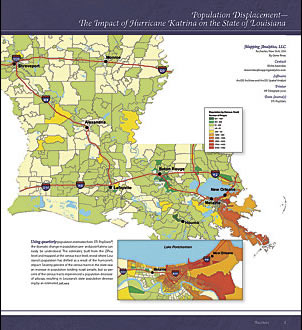|
 Correction—The Esri Map Book Vol. 21 included the map to the right by Mapping Analytics. The legend on the map should have identified the data source as being STI: PopStats. The correction has been made on the map as shown here, as well as the online version of the Esri Map Book at www.esri.com/katrinaimpact. Esri sincerely regrets any confusion or inconvenience this oversight may have caused. Correction—The Esri Map Book Vol. 21 included the map to the right by Mapping Analytics. The legend on the map should have identified the data source as being STI: PopStats. The correction has been made on the map as shown here, as well as the online version of the Esri Map Book at www.esri.com/katrinaimpact. Esri sincerely regrets any confusion or inconvenience this oversight may have caused.
Population Displacement
What was to become known as Hurricane Katrina started as a tropical depression over the Bahamas on August 23, 2005. On the 24th, it changed from a depression to a storm and was officially named Katrina. On August 28, it gained Category 5 status and on the 29th had its second landfall and touched down as a category 3 on the Louisiana coastline.
Using quarterly population estimates from STI: PopStats, the dramatic change in population pre- and post-Katrina can easily be understood. The estimates, built from the ZIP+4 level and mapped at the census tract level, reveal where Louisiana's population has shifted as a result of the hurricane's impact. Seventy percent of the census tracts in the state saw an increase in population totaling 11,746 people, but 30 percent of the census tracts experienced a population decrease of 460,190, resulting in Louisiana's state population decreasing by an estimated 348,444.
Nevertheless, identifying the emerging population shifts and trends as a result of this massive change will continue to be the biggest challenge in estimating the disaster. Though many of New Orleans's core infrastructures are back on line and normal data sources for estimating populations are returning—especially postal delivery statistics—the city's environment is still in flux, which means change most likely will not follow a traditional path of population growth. Still, many retailers and restaurants are back in business, while other business owners are evaluating when and where to rebuild.
|